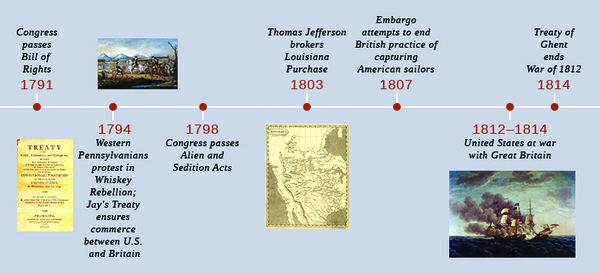| << Chapter < Page | Chapter >> Page > |

In June 1788, New Hampshire became the ninth state to ratify the federal Constitution, and the new plan for a strong central government went into effect. Elections for the first U.S. Congress were held in 1788 and 1789, and members took their seats in March 1789. In a reflection of the trust placed in him as the personification of republican virtue, George Washington became the first president in April 1789. John Adams served as his vice president; the pairing of a representative from Virginia (Washington) with one from Massachusetts (Adams) symbolized national unity. Nonetheless, political divisions quickly became apparent. Washington and Adams represented the Federalist Party, which generated a backlash among those who resisted the new government’s assertions of federal power.
Though the Revolution had overthrown British rule in the United States, supporters of the 1787 federal constitution, known as Federalists, adhered to a decidedly British notion of social hierarchy. The Federalists did not, at first, compose a political party. Instead, Federalists held certain shared assumptions. For them, political participation continued to be linked to property rights, which barred many citizens from voting or holding office. Federalists did not believe the Revolution had changed the traditional social roles between women and men, or between whites and other races. They did believe in clear distinctions in rank and intelligence. To these supporters of the Constitution, the idea that all were equal appeared ludicrous. Women, blacks, and native peoples, they argued, had to know their place as secondary to white male citizens. Attempts to impose equality, they feared, would destroy the republic. The United States was not created to be a democracy.
The architects of the Constitution committed themselves to leading the new republic, and they held a majority among the members of the new national government. Indeed, as expected, many assumed the new executive posts the first Congress created. Washington appointed Alexander Hamilton, a leading Federalist, as secretary of the treasury. For secretary of state, he chose Thomas Jefferson. For secretary of war, he appointed Henry Knox, who had served with him during the Revolutionary War. Edmond Randolph, a Virginia delegate to the Constitutional Convention, was named attorney general. In July 1789, Congress also passed the Judiciary Act, creating a Supreme Court of six justices headed by those who were committed to the new national government.
Congress passed its first major piece of legislation by placing a duty on imports under the 1789 Tariff Act. Intended to raise revenue to address the country’s economic problems, the act was a victory for nationalists, who favored a robust, powerful federal government and had worked unsuccessfully for similar measures during the Confederation Congress in the 1780s. Congress also placed a fifty-cent-per-ton duty (based on materials transported, not the weight of a ship) on foreign ships coming into American ports, a move designed to give the commercial advantage to American ships and goods.

Notification Switch
Would you like to follow the 'U.s. history' conversation and receive update notifications?